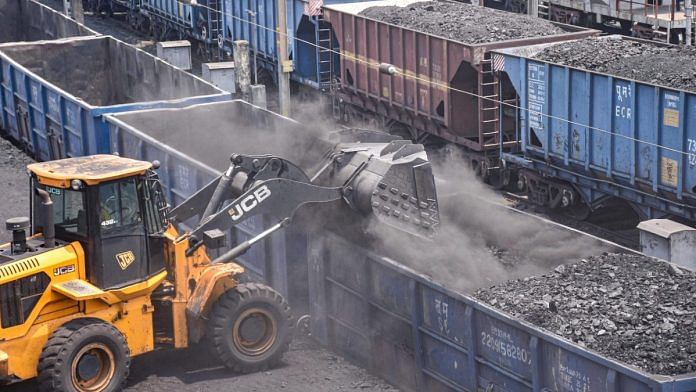New Delhi: To avoid a repeat of the April episode, when the shortage of rail rakes compounded a severe power crisis, the government has directed eight state-run power generation companies to buy their own rail rakes for coal evacuation during the monsoon season, ThePrint has learnt.
The move will ensure smooth power generation in the monsoon (June-September) months when coal shortage rises, a senior power ministry official said.
In the first two months of this financial year, several power plants ran out of coal due to delays in its transportation from mines. As a result, the Indian Railways had to cancel passenger trains to make way for freight trains.
The power ministry has written to NTPC Limited, Damodar Valley Corporation, and the state-run utilities of Punjab, Rajasthan, Uttar Pradesh, Maharashtra, Andhra Pradesh and Haryana, to keep a minimum buffer of 70 rakes and not depend entirely on the railways for evacuation of coal.
“In June, we wrote to the eight power companies to have their infrastructure ready. No one can deny that there is a supply side (coal availability) crisis and monsoon months will be tougher,” the senior official said.
The Indian Railways is reportedly planning to buy 1 lakh wagons — over and above what they have — in the next 3-5 years to meet the rising demand for coal freight, diversifying its freight basket. However, the procurement is yet to kick off.
Experts say apart from the rising coal imports, the biggest worry is about the evacuation infrastructure, which needs to be ramped up so that there is no shortage of coal in power generation.
“There is a lot of focus now on developing the evacuation infrastructure. After the rains, during September, evacuation infrastructure and wagon availability will remain a big monetary spend since we are normalising inventory,” Hetal Gandhi, Director, CRISIL Research, told ThePrint.
“That is why we believe imports will remain a critical part of India’s power sector in 2022-23.”
In a regulatory filing last week, state-owned Coal India informed the stock exchanges that it recorded a 65 per cent increase in capital spending during the April-June quarter due to strong spending in acquiring land and strengthening transport infrastructure in the coalfields under first-mile connectivity projects.
In total, Coal India’s capital spending (funds spent on the acquisition of long-term assets) for April-June came to about Rs 3,034 crore. Acquisition of new land, which often results in displacement of the local populace, is key to increasing mining output and opening of new mines.
According to government officials, the plan to buy 1 lakh additional wagons is still in the works.
Under the National Rail Plan, the government wants to significantly enhance the freight capacity of the Indian Railways to meet the estimated future demand of over 6,300 million tonnes by 2026 and 8,220 million tonnes by 2031. Currently, the railways deliver a little over 1,400 million tonnes of freight and plan to touch 2,000 million tonnes by 2024.
In June, it was reported that the Indian Railways was mulling upgrading its track infrastructure near coal mines to expedite the transportation of the fossil fuel to power producers in Bihar, Jharkhand and Odisha.
Also Read: How India’s power crisis is self-made & why we could face another crunch during the monsoon
Coal supply up to meet power demand
The total supply of coal to the power sector in June was 64.89 million tonnes, an increase of 30.8 per cent from the same period last year, according to a coal ministry release. At the same time, the overall coal supply increased by 20.69 per cent to 75.46 million tonnes in June 2022, from 62.53 million tonnes in June 2021.
The rise comes on the back of the government’s efforts to preserve coal in the monsoon season when quarrying becomes difficult due to recurring floods in mines. To avoid blackouts, the government has mandated all power producers to import 10 per cent of their coal demand for blending, following which many states have placed their orders.
India’s total installed coal-fired power generation capacity is 204.9 gigawatts (GW). Of this, around 17.6 GW or 8.6 per cent is generated through imported coal.
According to the power ministry official cited above, the total power demand in India for 2022-23 is estimated at 1,180 billion units (BU). While 1,119 BU of demand will be met through the domestic coal supply, the rest will be met by imported coal.
(Edited by Tony Rai)
Also Read: Modi govt asks coal plants to operate at full capacity to address power crisis



